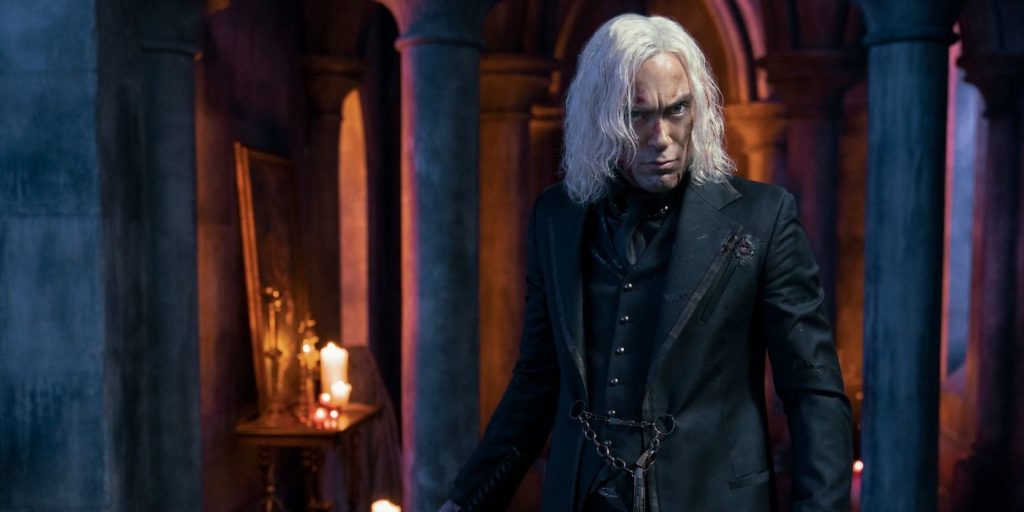The recurring theme of protagonist Spike’s enigmatic past is one of the most enduring aspects of the iconic 1990s animation Cowboy Bebop. The details of Spike’s time with the Red Dragon Crime Syndicate are at best hazy; he had relationships with a woman named Julia and a fellow criminal named Vicious, both of which ended for unknown reasons, and eventually he left the Syndicate. However, they are always present in the background of Spike’s mind as well as the plot. Exact details of any period in Spike’s life before the start of the series are never truly given, in stark contrast to how shows today feel the need to explain everything, making his continual flight from the past he doesn’t want to face more allegorical than literal.
On the other hand, Netflix’s live-action adaptation of Cowboy Bebop completely discards the original’s surreal depiction of Spike’s (John Cho) life and chooses to make it the focal point that unites nearly every episode. The crew of the Bebop were followed on a range of fairly solo adventures in the original series, but in Netflix’s Cowboy Bebop, Spike’s former foe Vicious (Alex Hassell) appears in every scene. Vicious and the Syndicate are somehow connected to every botched drug transaction, terrorist scheme, and fugitive from justice. Even if they aren’t directly involved in an episode’s present events, it may occasionally cut away to Vicious and Julia (Elena Satine), who are constantly devising new ways to obstruct Spike. Additionally, Spike and Julia’s romance is precisely the reason the trio split up because of Vicious’ treachery, making their relationship considerably more detailed.
It makes sense that the authors of Netflix’s version of this narrative would want to emphasise Vicious more. Cowboy Bebop lacks a pre-packaged, simple-to-grasp hook that would keep viewers’ attention riveted to the screen and allow Netflix’s autoplay to continue until the show’s episode count is reached. Vicious being intertwined throughout the story provides viewers a reason to binge watch in order to learn more about Spike, Vicious, Julia, and the Syndicate. Making it more bingeable necessitates creating a tonne of lore when none previously existed. Additionally, forcing everything to be connected undermines the original’s celebration of life’s transitory joys and tragedies. In addition, Hassell’s portrayal of Vicious absolutely steals the show, at least in part due to the amount of creative licence he was given. Vicious has so little character development in the anime that Hassell’s portrayal of him is given the freedom to be emotionally engaging and, quite frankly, more entertaining than might have previously been thought possible, whereas the rest of the cast feels somewhat constrained by expectations that they behave and look like their anime counterparts.
To be honest, it also doesn’t stem from an ignorance of the goals of the first episode. No matter what mood or setting Cowboy Bebop chooses that week, the series always feels like the same programme with the same characters because every character is evading a history they don’t want to recognise in their own unique ways. Wanting to learn more about Spike’s troubled history is a natural desire given how crucial it is to both his character and the overall themes of the show. And it’s not like the methods the Netflix programme uses to delve deeper into Spike’s past are arbitrary; since Spike’s past is up to interpretation, Netflix’s selections feel like logical extensions of the information we already have. The anime Bebop story’s complexities are hazy, but not unknowable, and focusing its adaptation on the parts of the plot that have never been addressed helps it feel like it has a purpose beyond merely adapting the cartoon to a new media.
It does, however, leave out something far more significant: the reasons behind the original show’s decision to avoid going into great detail about Spike’s past and the benefits of doing so. When a viewer sees Spike beating himself up about choices he made in the past, the haziness of his regrets inspires them to see their own pasts in his. Spike’s remorse over Vicious and Julia is effectively depicted in the anime through dream-like images. It’s challenging to relate to Spike’s backstory in the live-action series because it’s presented so exhaustively. Spike explicitly states, “I’m the orphan,” at one point—a claim that might be inferred but is never made in the original show—making it clear that this is his story and leaving no room for interpretation. But in the anime, Spike’s emotions are shared by all. Everyone has unfinished business they’d prefer not to consider, individuals they wish they could see again, and deeds they wish they could undo. In order to avoid being bogged down by its own backstory, the anime offers us just enough insight into Spike and each character overall so that we can identify with them. This creates the ideal conditions for emotional resonance, which keeps the programme feeling new no matter how much time passes.
Netflix’s adaptation does a disservice to its own themes and characters by making Vicious and Julia recurring characters who appear repeatedly and by revealing more about the Syndicate and Spike’s previous transgressions than the anime ever considered essential. Vicious loses the allure that made him so alluring in the first place as he transitions from being a ghost haunting Spike’s conscience to a cackling mastermind. Few people have the mustache-twirling villain that Netflix’s Vicious becomes, and that change causes more harm to the power of Cowboy Bebop’s structure than anything else. Everyone has an anime Vicious in their lives, a representation of their mistakes and regrets. Simply said, there are some things that are best left unsaid, and this kind of restraint is a crucial aspect of the original Cowboy Bebop that has been completely lost in this updated version of the enduring series. Simply leaving Vicious alone was the right thing to do.



